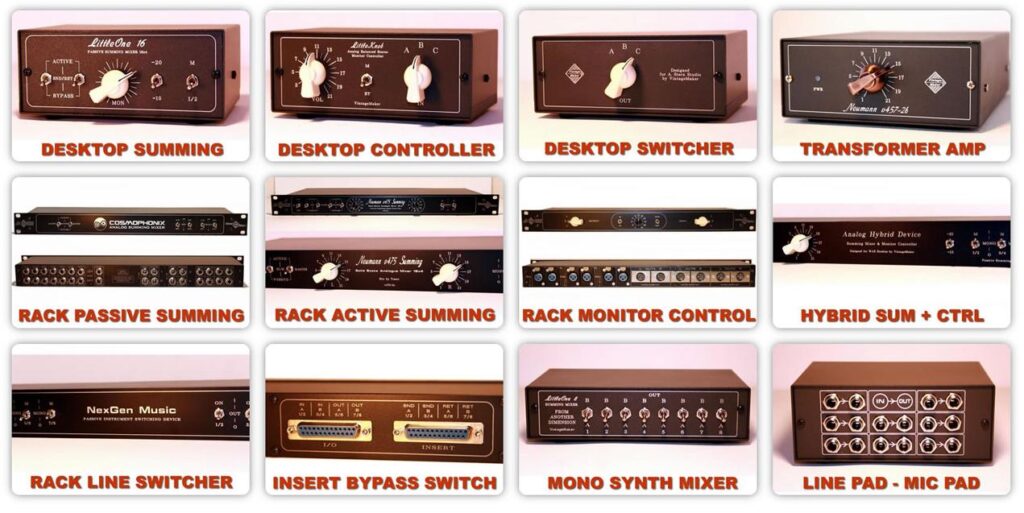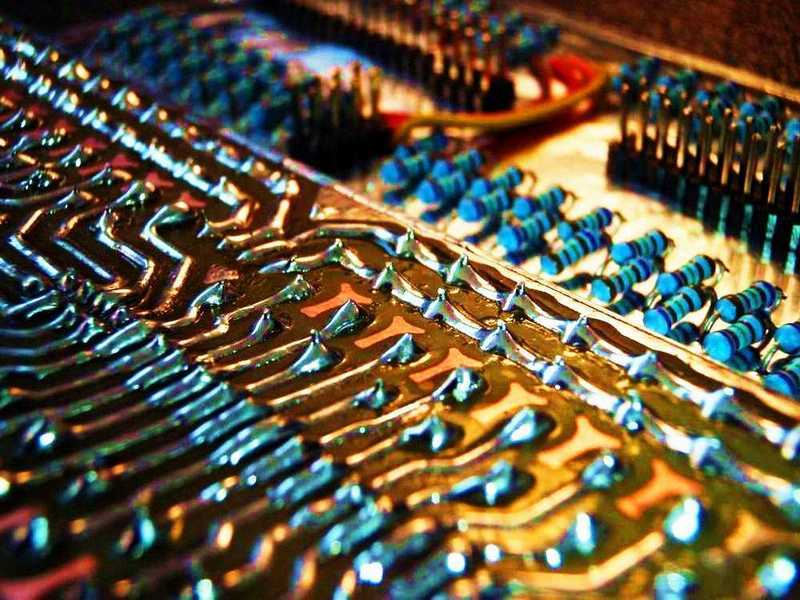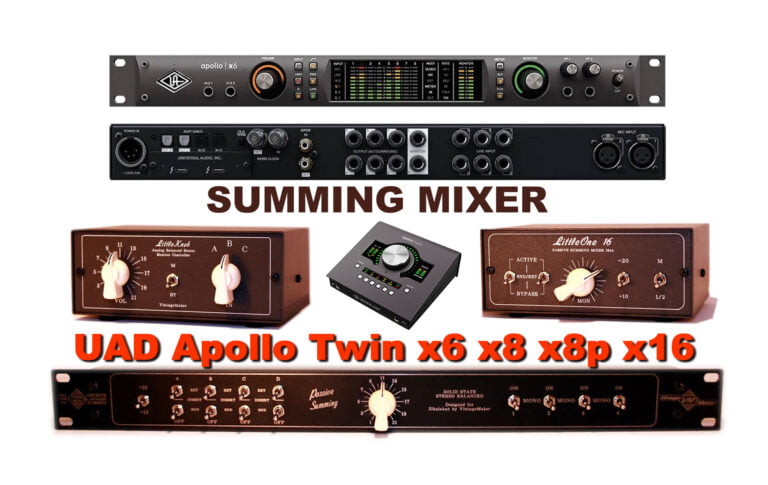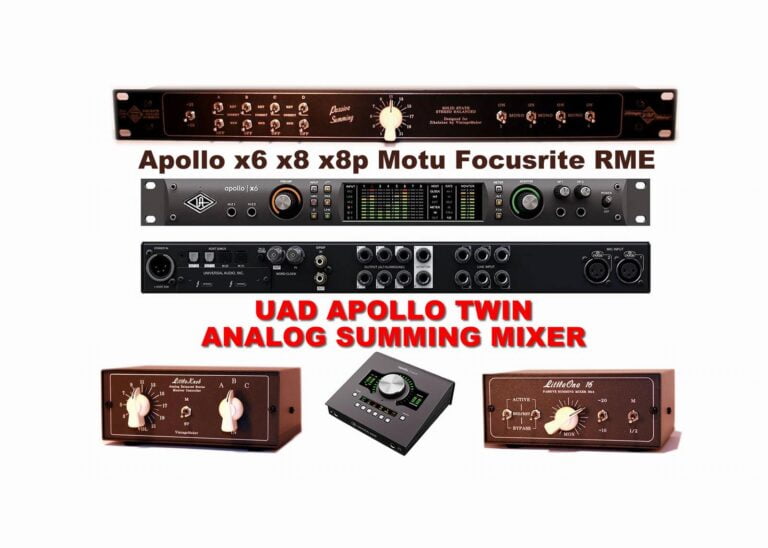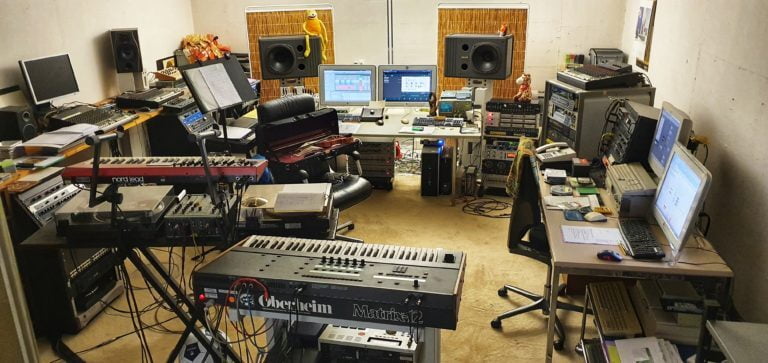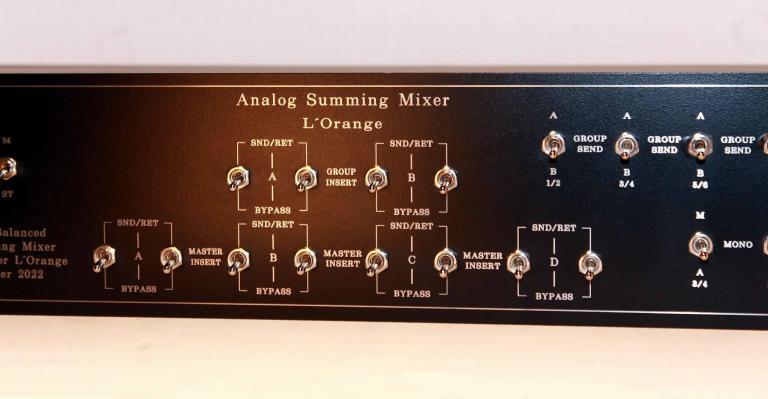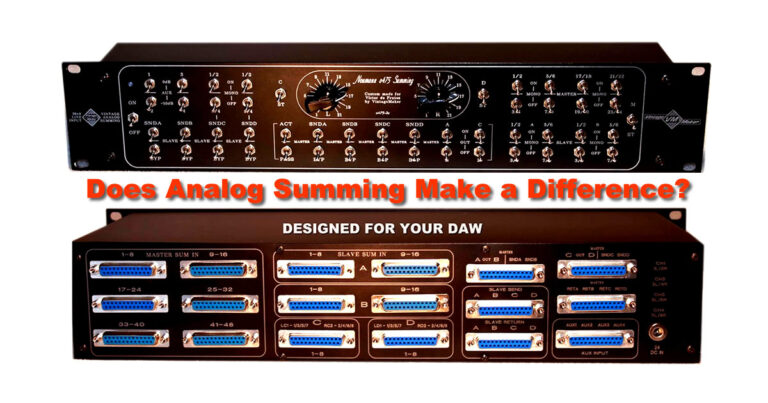How Analog Summing Adds Warmth & Rich Harmonics to Your Mix – Analogue Warmth – Analog Mixer Benefits – Harmonic Distortion
Getting a Better Studio Mix – Analog Summing Mixer – Warm 3D sound – How to Add Harmonic Distortion for Analogue Warmth – Analog Summing Benefits -Harmonics – Harmonic Distortion
Is analog summing truly beneficial? Do summing mixer add warm analog color harmonics? How significant is analog summing? Is there a noticeable advantage to using analog summing, or is it just an optional addition? What is the role of summing mixers in audio production? Understanding the Analogue Warmth and its relationship with Analog Summing Benefits can elevate your audio production experience significantly.
If you’ve ever had these questions cross your mind, rest assured you’re in good company. Many studio producer share the concern of maintaining audio quality and preventing degradation when ITB exporting or printing to a file in the DAW.
Transform your personal studio into a professional powerhouse with the VintageMaker analog summing mixer — crafted to bring your music the warmth, richness, and clarity only top-tier big studio consoles can deliver, without taking up half your space or breaking the bank.
Why choose analog summing instead of doing the entire mix digitally?
- True big studio sound, right in your Studio!
Experience the expansive depth, wide stereo image, and lush analog warmth that legendary consoles are known for. - Mix like a pro every time
Create polished, vibrant mixes that captivate your audience and make your music shine. - Goodbye digital harshness
Escape the sterile, compressed sound of in-the-box mixing and embrace smooth, natural analog character. - 100% real analog summing
No software tricks or emulations — just pure, discrete analog circuitry delivering authentic tone. - Designed to fit your space and style
Choose desktop or rack-mounted options — professional quality in a format that works for you. - Studio-grade sound without the studio price
Get premium analog quality that won’t drain your budget.
The Two Master Key Principles of Analog Summing
1. Input Signal Level is Everything
The level of the input signal plays a crucial role in analog summing. The more gain you drive into the summing stage, the more natural analog harmonics you introduce — it’s simple physics. As you feed more channels into the summing box, you begin to approach the sweet spot where gentle harmonic distortion starts to take shape. This is where the magic happens: first-order analog harmonics begin to emerge, adding natural depth and musicality to your mix.
With proper panning, analog summing creates clear instrument separation and a wider stereo image. Unlike digital systems, analog summing imposes virtually no limit on the number of input channels, so you can truly open up your mix and give it room to breathe.
So again, the key thing is to send a stronger signal to the summing box in order to reach the threshold of pleasant harmonic distortion in the summing circuit. This way, you’ll achieve extra harmonic content and a truly analog sound..
2. Add Harmonics with Your DAW Preamps or Internal Neumann or Filtek Transformers
Adding your DAW preamps or vintage transformer amplifiers to the master bus — such as Neumann or Filtek — introduces an additional layer of harmonic richness. These classic transformers enhance the fundamental tone while generating natural 2nd and 3rd order harmonics, giving your master stereo that unmistakable analog warmth, depth, and a more three-dimensional sound.
Through the unique Active/Passive option (which I designed and is exclusive to VintageMaker), you can integrate external preamps — whether it’s your favorite mic pres, DAW sends, or outboard amps. This dual-function summing feature allows you to work with or without the internal Neumann or Filtek transformers, or even combine your gear with them. The result? A wide palette of tonal possibilities tailored to your creative vision.
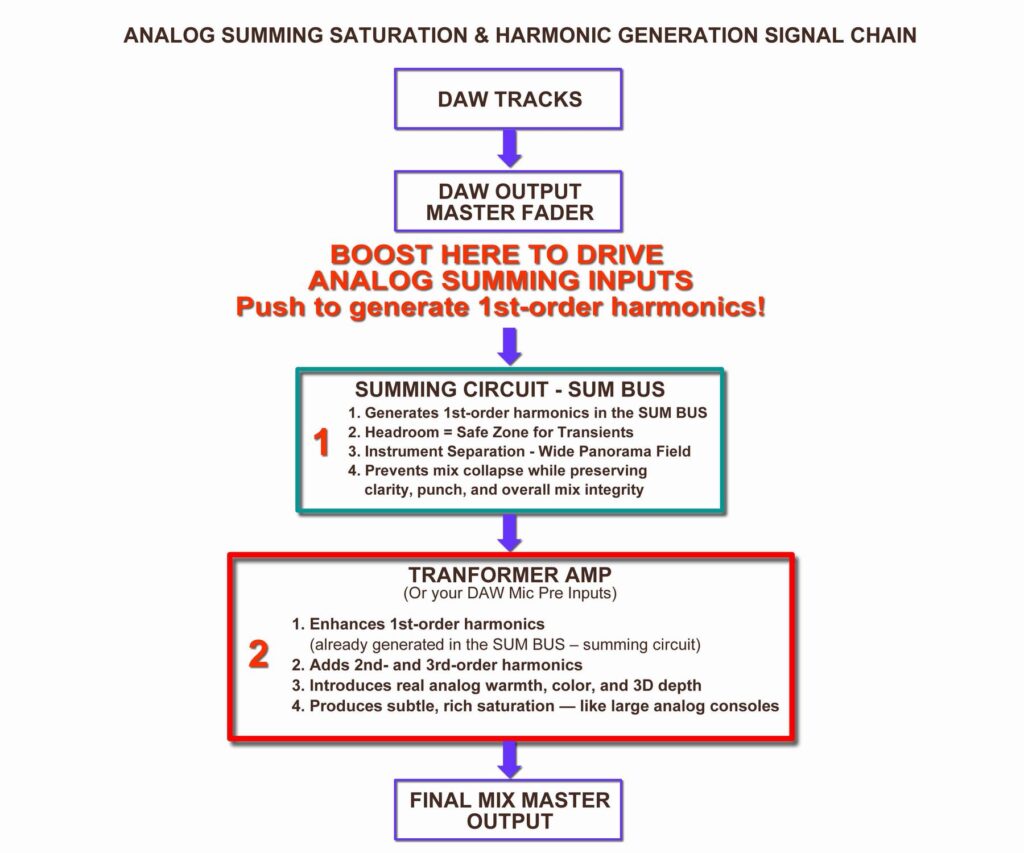
In short, the SUM BUS, with its summing mixer input resistor network, establishes a protective Headroom zone. This Headroom ensures a secure space for your audio content, preserving the individual instrument focus and their correct placement within the stereo field for a wide, deep 3D sound.
By proper gain staging (sending higher-level audio signals to the summing inputs from the DAW interface outputs) and gently introducing analog harmonic distortion, you retain and capture the essential harmonics within the SUM BUS, which are subsequently combined into a master stereo track. Then pass them (main rec record master stereo) through your DAW interface preamp or a transformer amp. Here, the (VCA) amplifier uplifts and boosts fundamental harmonics (which were created in the sum bus) and introduces additional excitement and saturation, enhancing the complex harmonics and creating the warm analog color character sound… read the full version here: https://vintagemaker.net/tag/what-does-a-summing-mixer-do/
7 Reasons to use Analog Summing Mixer Box – Unlock True Analog Depth in Your Studio – Analog Summing has No Limits!
When it comes to mixing, achieving depth, clarity, and warmth is crucial for a professional sound. While digital summing has its advantages, it can sometimes lead to a mix that feels flat and congested. This is where analog summing comes in, offering a more immersive and natural sonic experience.
Why Choose Analog Summing?
Analog summing allows for a richer, more dynamic mix by preserving the nuances and spatial characteristics of each track. Here are some key benefits:
1. Your mix will never collapse! Every instrument remains sharp and defined, even with 100+ inputs.
Summing mixer circuit designed by VintageMaker provides unparalleled depth and clarity. Unlike digital summing, which can sometimes make tracks feel flat and congested, an analog summing box mixer ensures every element in your mix stays sharp, dynamic, and well-defined.
2. Superior Depth & Clarity
Analog summing enhances stereo imaging, creating a wider and more open mix. By naturally spreading frequencies, each element in the mix retains its clarity and position, resulting in a more immersive soundstage.
3. Warm, Harmonic-Rich Tone
One common complaint about digital processing is that it can sound sterile or clinical. Analog summing introduces subtle harmonic saturation, adding warmth and musicality that is often missing in purely digital workflows. This is particularly relevant when considering the Analogue Warmth – Analog Summing Benefits – Harmonics – Harmonic Distortion.
4. Increased Headroom & Dynamic Range
Analog summing mixers provide additional headroom, reducing digital harshness and ensuring smoother signal peaks. This allows for a more natural balance between soft and loud elements in your mix.
5. Better Instrument Separation
Each instrument maintains its space and definition, preventing mix collapse. This is particularly useful in complex arrangements where multiple layers need to be clearly distinguishable.
6. Flexible Hybrid Workflow
Analog summing integrates seamlessly into digital setups, allowing engineers and producers to combine the best of both worlds. External gear, such as compressors and EQs, can be incorporated for added sonic shaping.
7. More Engaging Listening Experience
Mixes processed through analog summing are often described as more engaging and musical. The subtle nuances, improved transient response, and refined high-end contribute to a sound that feels more organic and immersive.
Is an Analog Summing Mixer Right for You?
For those seeking a professional-quality mix with enhanced depth and character, analog summing can be a game-changer. Whether you’re working on intricate productions or looking to add warmth and polish to your mixes, incorporating analog summing can help you achieve a more refined and natural sound.
Would you like to explore different summing mixer options? There are various configurations available, from compact desktop units to high-end rackmount systems. If you’re curious about how analog summing can elevate your mixes, consider researching reputable manufacturers and user reviews to find the best fit for your studio needs.
Customer says: I fed my studio converters with the hottest signal in the center of the panorama and started automating the faders around it.
Soon enough, the magic happened: the summing box started purring like a happy big cat and I knew that was the sound I always struggled to reach, the famous and legendary “warmth and openness of analog” I so many times read about. “The analog sweetspot”.
Lets see what’s happen in a PASSIVE SUMMING (inputs) called SUM BUS
When the audio signal overloads the SUM BUS, it generates a pleasing, harmonically-rich distortion that adds a gentle warmth to the sound.
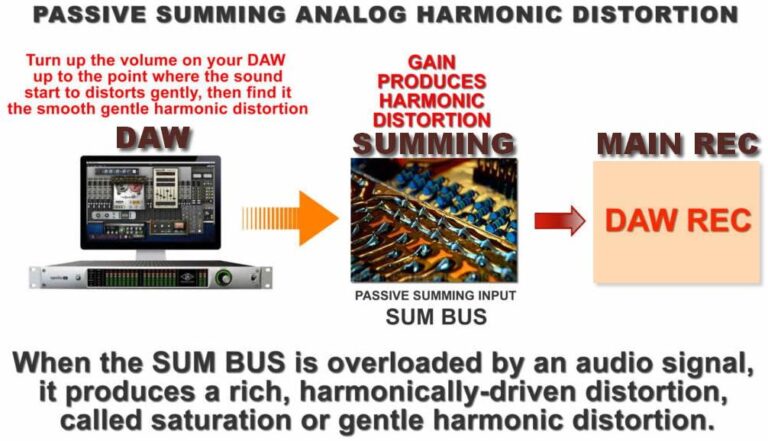
How to hit the gentle analog harmonic distortion on the PASSIVE summing inputs?
Simply boost up your DAW output Level – and you get some “nice” distortion because you’re pushing the SUMMIN INPUTS (SUM BUS) – quite a bit OVER its nominal level. (after that gain up the summed signal by your internal amp or external mic preamps or DAW mic preamps)
Surprisingly, proper gain staging is often overlooked or disregarded by many, yet it stands as one of the most critical and indispensable aspects of the analog mixing process.
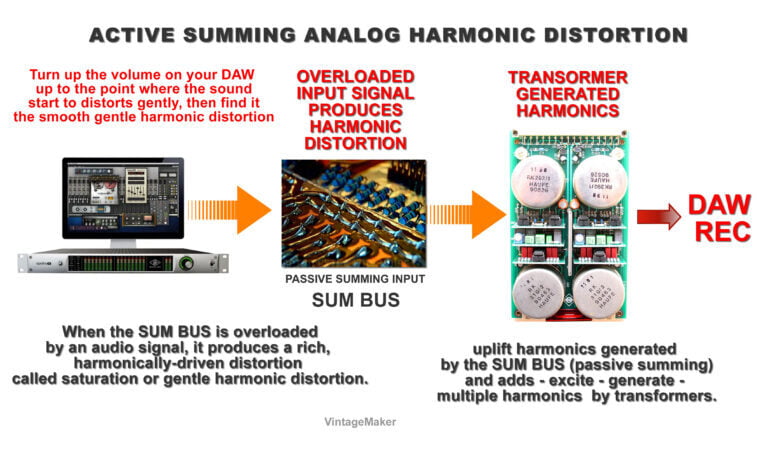
Analog professional equipment such as a summing mixer is typically designed to operate at a +4dB level but has the capacity to produce output levels as high as +24dB. This means that when operating at 0 VU, you have a generous 20dB of built-in headroom (calculated as 24 – 4 = 20).
Headroom = Safe Place for transients, harmonics, instrument separation and more
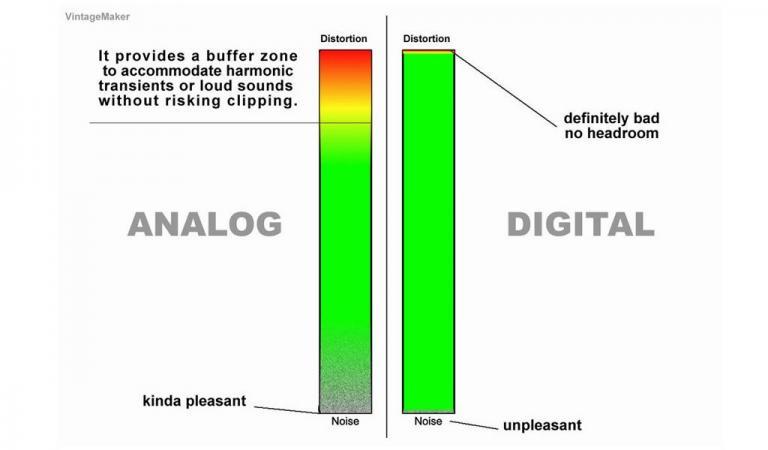
What is the analog mixer Headroom?
Headroom, in simple terms, is a safe zone for your audio. It’s the space where transients remain undistorted and unharmed. It’s the margin your audio signal has before it faces compression and distortion. This buffer zone allows for the presence of harmonics, transients, or loud sounds without the risk of clipping, resulting in a more dynamic, open, and wide, three-dimensional sound. Additionally, headroom also accommodates gentle harmonic distortion, encompassing both harmonic and non-harmonic distortions, adding analog nonlinearities to the mix. Read more at: https://vintagemaker.net
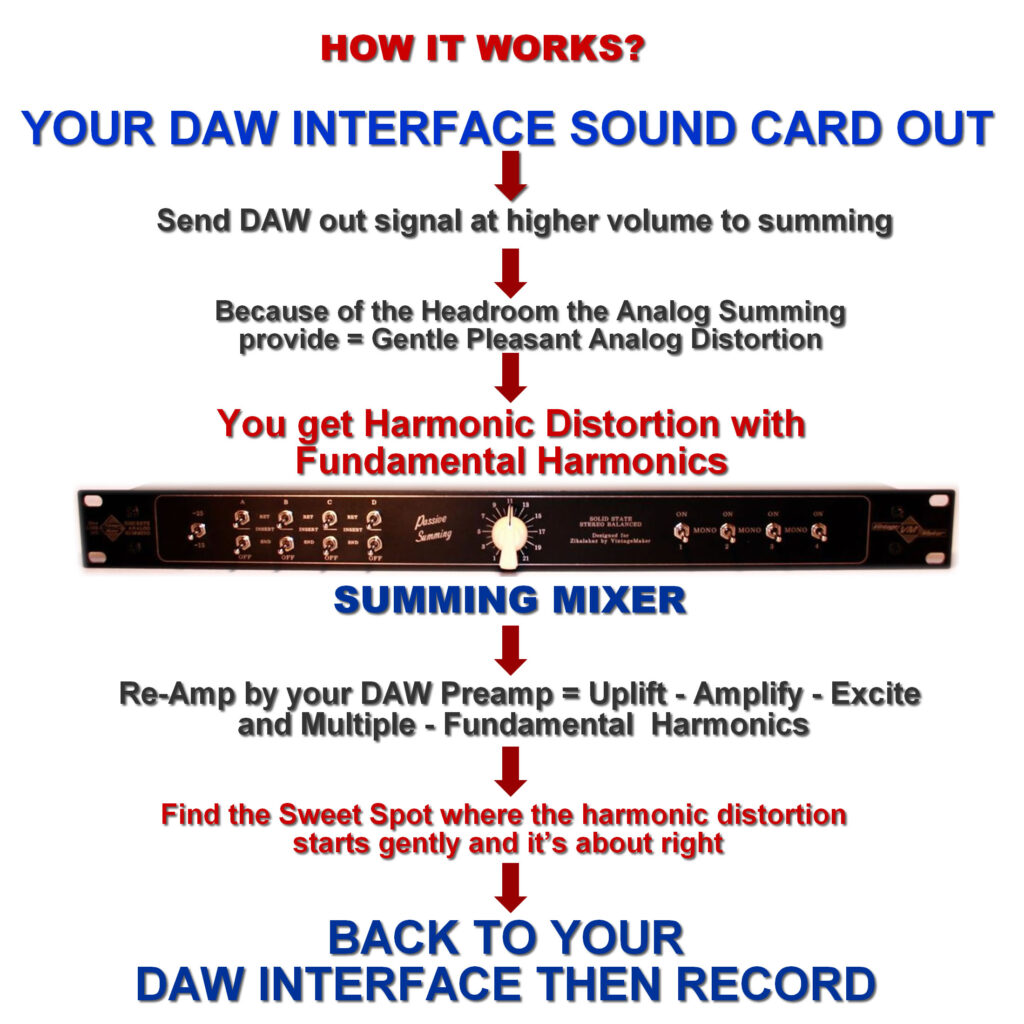

Do not find your Studio Gear?
Don’t worry! Just inform me about your requirements!
Explore how analogue warmth enhances harmonics and harmonic distortion for a richer, dynamic sound with our summing mixer. Analog Analogue Warmth with summing mixer, enhancing analog summing benefits, harmonics, and harmonic distortion for a dynamic 3D sound. Analogue Warmth – Analog Summing Benefits
